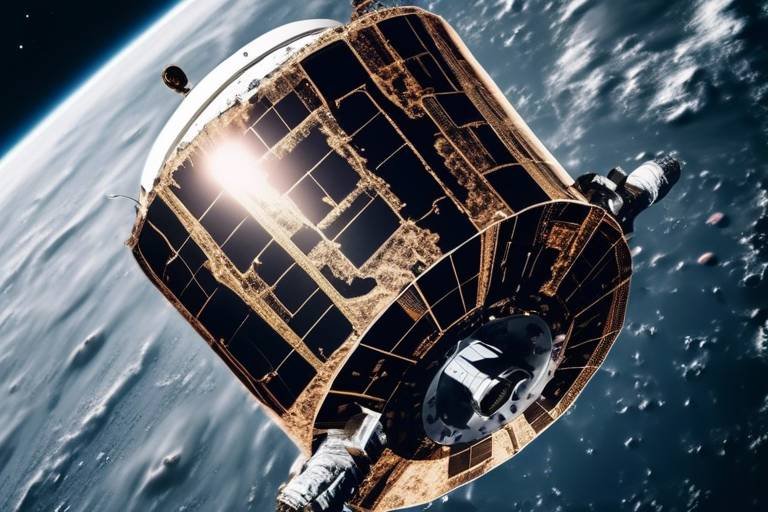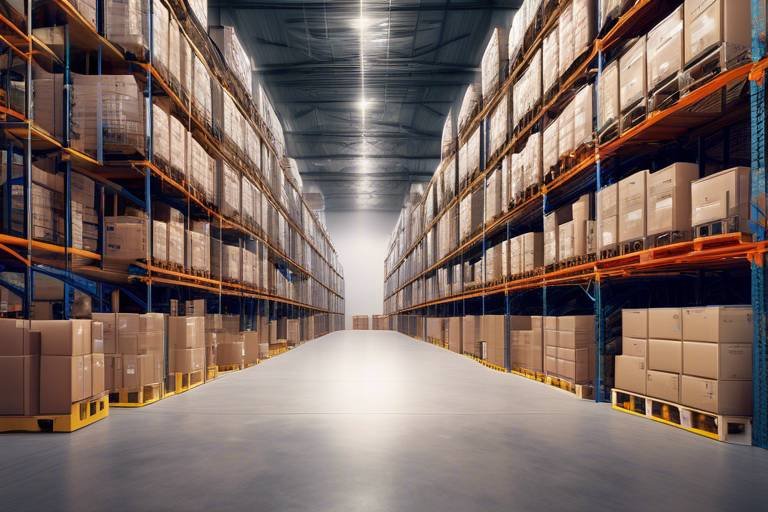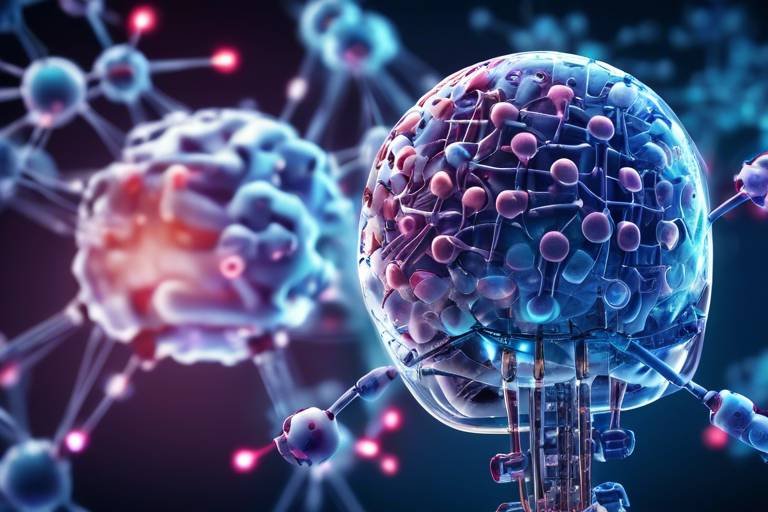Role of AI in Curbing Plastic Pollution
The fight against plastic pollution is one of the most pressing environmental challenges of our time. As we see the devastating effects of plastic waste on marine life, wildlife, and even human health, the urgency to find effective solutions has never been greater. Here’s where artificial intelligence (AI) steps into the spotlight, offering innovative tools and strategies that can help us turn the tide against plastic pollution. Imagine a world where advanced algorithms and smart technologies work together to create cleaner oceans and healthier ecosystems. Sounds like science fiction? Well, it’s becoming a reality!
AI can analyze vast amounts of data at lightning speed, allowing us to understand the sources and impacts of plastic waste better than ever before. From identifying pollution hotspots to optimizing recycling processes, AI technologies are transforming how we approach waste management. For instance, AI-powered sorting systems can distinguish between different types of plastics, ensuring that more materials are recycled rather than ending up in landfills or, worse, our oceans.
Moreover, AI doesn’t just stop at recycling. It plays a crucial role in monitoring and tracking plastic waste, providing real-time insights that can drive policy changes and community initiatives. By leveraging satellite imagery and mobile applications, AI can empower citizens to take action against plastic pollution in their own neighborhoods. This is not just about technology; it’s about creating a movement where everyone can participate in safeguarding our planet.
In this article, we will explore the multifaceted role of AI in curbing plastic pollution, highlighting innovative approaches, technologies, and collaborative efforts that can ultimately lead to a cleaner, more sustainable environment. From smart sorting systems to predictive analytics, the potential of AI in this battle is vast and exciting. So, let’s dive deeper into how these technologies are making waves in the fight against plastic waste!
As we navigate through the complexities of plastic pollution, it’s essential to recognize that the solution lies not only in technology but also in our collective responsibility. By harnessing the power of AI and fostering collaboration across sectors, we can create a future where plastic pollution is significantly reduced, and our ecosystems can thrive once again. Stay tuned as we delve into the intricate details of how AI is reshaping waste management and environmental conservation.

Understanding Plastic Pollution
Plastic pollution is not just a buzzword; it’s a **growing environmental crisis** that is wreaking havoc on our ecosystems and posing serious threats to human health. Have you ever stopped to think about where all that plastic goes after we've used it? Unfortunately, much of it ends up in our oceans and landscapes, creating a toxic cocktail of waste that can take hundreds of years to decompose. The sources of plastic pollution are varied and ubiquitous, ranging from single-use items like straws and bags to larger debris like fishing nets and industrial waste. Each piece of plastic tells a story of **human convenience** and neglect, leading to dire consequences for wildlife and our planet.
The types of plastic waste are as diverse as their sources. Broadly, they can be categorized into two groups: **microplastics** and **macroplastics**. Microplastics, which are tiny particles less than 5mm in size, often originate from the breakdown of larger plastic items or from products like cosmetics and synthetic fibers. On the other hand, macroplastics include larger items that are easily visible, such as bottles, containers, and packaging materials. Both types pose significant threats to marine life, as animals can ingest or become entangled in plastic debris, leading to injury or death.
But what are the real consequences of plastic pollution? The effects ripple through our ecosystems and can even circle back to us. For instance, when marine animals ingest plastic, it can enter the food chain, eventually making its way to our dinner plates. This not only threatens the health of wildlife but also raises **serious concerns** about human health, as we unknowingly consume plastic particles. Moreover, plastic pollution contributes to the degradation of natural habitats, disrupting ecosystems and leading to a loss of biodiversity.
To give you a clearer picture, here’s a brief overview of the consequences of plastic pollution:
| Type of Impact | Description |
|---|---|
| Environmental Impact | Disruption of ecosystems, loss of biodiversity, and habitat destruction. |
| Health Risks | Potential ingestion of microplastics by humans and animals, leading to health complications. |
| Economic Costs | Cleanup costs, loss of tourism revenue, and impacts on fisheries. |
In summary, understanding plastic pollution is crucial for addressing this pressing issue. It’s not just about the visible trash we see on the beaches or in the oceans; it’s about the invisible impacts that seep into our ecosystems and our own bodies. By raising awareness and taking action, we can begin to turn the tide against plastic pollution and work towards a cleaner, healthier planet.

AI Technologies in Waste Management
Artificial intelligence (AI) is making waves in the world of waste management, and it's about time! With the overwhelming amount of waste generated daily, traditional methods just can’t keep up. Thanks to AI technologies, we are now witnessing a transformation that enhances efficiency, reduces costs, and promotes sustainability. Imagine a world where waste is sorted automatically, recycling rates soar, and landfills are minimized. This is not just a dream; it’s becoming a reality through the innovative application of AI in waste management.
At the core of this revolution are advanced technologies such as machine learning and robotics. These tools are not only streamlining waste processing but also ensuring that the materials that can be recycled are effectively separated from those that cannot. For instance, smart sorting systems use AI algorithms to identify and categorize different types of plastics, which is crucial for improving recycling rates. By reducing contamination in recycling streams, these systems enable cleaner, more efficient recycling processes.
Now, let’s dive a bit deeper into how these technologies work. Smart sorting systems rely on sophisticated image recognition algorithms that can analyze the characteristics of plastic materials. Picture this: a conveyor belt filled with a mix of plastics, metals, and organic waste. The AI-powered system scans each item, identifies its type, and sorts it accordingly. This level of precision not only speeds up the sorting process but also significantly increases the quality of the recycled materials. It’s like having a super-efficient assistant that never gets tired and can work around the clock!
Moreover, robotic automation is another game-changer in waste management facilities. Robots equipped with AI can handle repetitive tasks that are often dangerous or tedious for humans. They can pick up and sort materials with remarkable speed and accuracy, reducing human error and increasing overall efficiency. Imagine robots working alongside humans, creating a harmonious environment where both can thrive. This integration not only enhances productivity but also allows human workers to focus on more complex and strategic tasks, ultimately leading to a more effective waste management system.
But it doesn’t stop there! AI technologies are also paving the way for predictive analytics in waste generation. By analyzing historical data and current trends, AI can forecast future waste generation patterns. This insight is invaluable for municipalities aiming to allocate resources more effectively. Instead of waiting for waste to pile up, cities can proactively manage their waste collection schedules, ensuring that they are prepared for peak times. It’s like having a crystal ball that helps city planners make informed decisions to keep their communities clean and sustainable.
In summary, AI technologies are revolutionizing waste management by enhancing sorting processes, automating tedious tasks, and providing predictive insights. The future of waste management looks brighter than ever, and as we continue to harness the power of AI, we can look forward to a cleaner, more sustainable world.

Smart Sorting Systems
In the battle against plastic pollution, powered by artificial intelligence are emerging as game-changers. Imagine a world where machines can effortlessly distinguish between different types of plastics, ensuring that recyclable materials are processed correctly. This is not just a dream; it’s a reality that is transforming waste management. These systems utilize advanced algorithms and machine learning techniques to enhance the efficiency of recycling processes, ultimately leading to higher recycling rates and less contamination in recycling streams.
At the heart of these smart sorting systems lies the ability to analyze and categorize materials at lightning speed. Traditional sorting methods often rely on human labor, which can be slow and prone to errors. In contrast, AI-driven systems can quickly identify various types of plastics, such as PET, HDPE, and PVC, using a combination of sensors and data analytics. This capability not only speeds up the sorting process but also significantly reduces the chances of non-recyclable materials contaminating the recycling stream.
Moreover, these systems are designed to adapt and learn over time. As they process more data, they become better at recognizing different plastic types and their properties. This adaptability is crucial, especially considering the ever-evolving landscape of plastic materials. For instance, manufacturers are constantly developing new types of plastics, and smart sorting systems can be updated to recognize these innovations, making them invaluable in the quest for effective waste management.
To illustrate the impact of smart sorting systems, consider the following table that outlines the benefits these technologies bring to the recycling industry:
| Benefit | Description |
|---|---|
| Increased Efficiency | AI systems can sort materials faster than human workers, significantly speeding up the recycling process. |
| Reduced Contamination | By accurately identifying plastics, these systems minimize the risk of non-recyclables entering the recycling stream. |
| Cost-Effectiveness | Automating the sorting process reduces labor costs and increases the overall profitability of recycling operations. |
| Data-Driven Insights | These systems provide valuable data on waste composition, helping municipalities and companies make informed decisions. |
In conclusion, smart sorting systems represent a significant leap forward in our ability to tackle plastic pollution. By harnessing the power of AI, we can not only improve recycling rates but also create a more sustainable future. The potential of these technologies is immense, and as they continue to evolve, we can expect to see even greater advancements in waste management practices.

Image Recognition Algorithms
Image recognition algorithms are transforming the landscape of recycling by providing an unprecedented ability to identify and categorize different types of plastics with remarkable accuracy. Imagine walking into a recycling facility where machines can instantly recognize a plastic bottle from a food container, all while you sip your coffee. This is not science fiction; it's the power of AI at work! These algorithms analyze visual data through complex neural networks, mimicking the way humans recognize objects, but at a scale and speed that far surpasses human capability.
At the core of these algorithms are deep learning techniques that train on vast datasets of images, enabling them to distinguish between various plastic types—like PET, HDPE, and PVC—based on their unique visual characteristics. For instance, a well-trained model can differentiate between a clear water bottle and a colored soda bottle, ensuring that each type is sorted into the correct recycling stream. This level of precision is crucial because it significantly reduces contamination rates, which is a major challenge in recycling efforts worldwide.
Moreover, the implementation of image recognition algorithms can lead to substantial cost savings for recycling facilities. By minimizing human intervention and enhancing sorting efficiency, these systems not only streamline operations but also maximize the amount of recyclable material recovered. A study showed that facilities using AI-driven sorting technologies could increase their recycling rates by up to 30%, a game-changer in the fight against plastic pollution.
To illustrate the impact of image recognition algorithms, let’s take a look at a simple comparison:
| Traditional Sorting | AI-Driven Sorting |
|---|---|
| Manual labor-intensive | Automated and efficient |
| Higher contamination rates | Lower contamination rates |
| Slower processing speed | Faster processing speed |
| Limited accuracy | High accuracy |
In addition to improving recycling processes, these algorithms also have the potential to enhance public awareness and engagement. By utilizing mobile applications that incorporate image recognition technology, individuals can take photos of littered plastics and receive immediate feedback on how to recycle them properly. This not only educates the community but also empowers them to take action against plastic waste, creating a collective movement towards a cleaner environment.
Overall, the integration of image recognition algorithms in recycling facilities is a pivotal step towards achieving a sustainable future. As these technologies continue to evolve, we can expect even greater advancements in how we manage and reduce plastic pollution. It's a fascinating time to be alive, witnessing technology and environmental stewardship come together for a common cause!

Robotic Automation
In the realm of waste management, is nothing short of a game changer. Imagine a world where machines, equipped with advanced AI, take on the heavy lifting of sorting and processing plastic waste. This isn't science fiction; it's happening right now! By integrating robotics into recycling facilities, we can significantly enhance efficiency and accuracy, which are crucial in tackling the plastic pollution crisis.
One of the primary benefits of robotic automation is the reduction of human error. Let's face it, humans can be prone to mistakes, especially in monotonous tasks like sorting through heaps of plastic. Robots, on the other hand, are designed to perform repetitive tasks with precision. They can be programmed to identify specific types of plastics and separate them from other materials, ensuring that the recycling process is as clean as possible. This leads to higher quality recyclables and reduces contamination rates in recycling streams.
Furthermore, robotic systems can operate continuously without the need for breaks, making them incredibly efficient. In a typical recycling plant, robots can work alongside human workers, handling the more tedious tasks while freeing up people to focus on more complex roles. This synergy between humans and machines not only boosts productivity but also creates a safer working environment by minimizing the risk of injury associated with manual sorting.
| Advantages of Robotic Automation | Description |
|---|---|
| Increased Efficiency | Robots can operate 24/7, significantly increasing the throughput of recycling facilities. |
| Improved Accuracy | Advanced sensors and AI algorithms enable robots to sort materials with high precision. |
| Cost-Effectiveness | While the initial investment may be high, the long-term savings in labor and increased recycling rates make it worthwhile. |
| Enhanced Safety | Robots can handle hazardous materials, reducing the risk of injury to workers. |
Moreover, the technology behind robotic automation is continuously evolving. Innovations in machine learning and computer vision allow these robots to learn and adapt over time, improving their sorting capabilities as they process more materials. This adaptability is crucial in a world where plastic waste comes in various forms and compositions, making it essential for recycling facilities to keep pace with changing waste streams.
As we look to the future, the role of robotic automation in waste management will only grow. With the increasing urgency to combat plastic pollution, investing in these technologies is not just a smart move; it's a necessary step towards a sustainable future. Imagine a world where our oceans and landscapes are free from plastic waste, and robotic systems play a vital role in making that dream a reality. It's time to embrace the revolution!

Predictive Analytics for Waste Generation
In the age of information, where data drives decisions, predictive analytics has emerged as a game-changer in waste management. Imagine having the ability to foresee waste generation patterns before they even happen—sounds like something out of a sci-fi movie, right? But thanks to artificial intelligence, it's becoming a reality. By analyzing historical data, AI can identify trends and predict future waste generation, allowing municipalities and organizations to allocate resources more effectively. This proactive approach not only saves money but also helps in reducing the environmental footprint.
So, how does it work? AI algorithms sift through massive datasets—think of everything from population growth to seasonal changes in consumer behavior. By correlating these factors with waste generation data, predictive models can forecast when and where waste will spike. For instance, during the holiday season, we see a significant increase in packaging waste. With predictive analytics, waste management systems can prepare in advance by deploying additional resources or optimizing collection routes. This means less overflow, fewer missed pickups, and ultimately, a cleaner environment.
Moreover, predictive analytics can also play a crucial role in developing tailored waste management strategies. Different neighborhoods generate different types of waste, and understanding these nuances can lead to more effective recycling programs. For example, a community that primarily generates organic waste can benefit from composting initiatives, while another that produces a lot of plastic can focus on enhancing recycling practices. By employing AI-driven insights, cities can create targeted campaigns that resonate with their residents, encouraging them to adopt sustainable practices.
To give you a clearer picture, here’s a simple table that outlines how predictive analytics can transform waste management:
| Predictive Analytics Application | Benefit |
|---|---|
| Forecasting Waste Generation | Allows for better resource allocation and planning |
| Identifying Waste Composition | Enables tailored recycling and composting programs |
| Optimizing Collection Routes | Reduces operational costs and improves efficiency |
| Enhancing Community Engagement | Encourages sustainable practices through targeted initiatives |
In essence, the integration of predictive analytics into waste management systems is not just a technological upgrade; it's a fundamental shift in how we approach waste. By leveraging data, we can create a more sustainable future where waste is minimized, recycling is maximized, and our planet remains healthy for generations to come. So, the next time you think about waste management, remember that the future is not just about cleaning up—it's about smart planning and informed decision-making.
- What is predictive analytics? It is a branch of advanced analytics that uses historical data, statistical algorithms, and machine learning techniques to identify the likelihood of future outcomes.
- How can predictive analytics help in waste management? It enables organizations to forecast waste generation patterns, optimize resource allocation, and tailor waste management strategies to specific community needs.
- Is predictive analytics expensive to implement? While there is an initial investment in technology and data analysis, the long-term savings and environmental benefits often outweigh the costs.
- Can small communities benefit from predictive analytics? Absolutely! Even small communities can utilize predictive analytics to improve their waste management processes and engage residents in sustainability efforts.

Monitoring and Tracking Plastic Waste
In our quest to combat plastic pollution, one of the most significant advancements lies in the realm of . With the rise of artificial intelligence, we now have powerful tools at our disposal that enable us to observe and analyze the distribution of plastic waste in real-time. This capability is crucial because it helps us understand the sources of pollution, assess its impacts, and develop effective strategies for mitigation. Imagine having a bird's-eye view of our oceans and landscapes, pinpointing exactly where plastic accumulates and how it moves through our ecosystems. Sounds incredible, right? Well, that’s the reality we’re stepping into.
AI technologies are transforming how we monitor plastic waste through various innovative methods. For instance, satellite imagery combined with AI algorithms allows researchers to collect vast amounts of data on plastic debris in oceans. This technology not only identifies the locations of floating plastics but also tracks changes over time, providing invaluable insights into the scale and distribution of plastic pollution. With this information, scientists can create detailed maps that highlight the most affected areas, helping to prioritize clean-up efforts and inform policy decisions.
Moreover, the use of mobile applications is another exciting development in engaging citizens in the fight against plastic pollution. These apps, powered by AI, enable individuals to report sightings of plastic waste in their communities. By harnessing the collective power of the public, we can gather real-time data on pollution hotspots. This grassroots approach not only raises awareness but also fosters a sense of responsibility among community members. Imagine a world where every citizen plays a part in monitoring their environment—this is the potential that AI-driven mobile platforms bring to the table.
Furthermore, the integration of AI into environmental sensors is revolutionizing how we track plastic waste. These sensors can be deployed in various ecosystems, from urban areas to remote beaches, collecting data on plastic concentrations and other relevant metrics. The data gathered can be analyzed to identify trends and patterns, allowing local governments and organizations to allocate resources more effectively. For example, if a particular area is found to have a high concentration of plastic waste, targeted clean-up initiatives can be implemented swiftly.
To summarize, the combination of AI technologies, satellite imagery, mobile applications, and environmental sensors is paving the way for a more comprehensive understanding of plastic pollution. By continuously monitoring and tracking plastic waste, we can develop informed strategies to combat this pressing issue. As we embrace these technologies, we not only enhance our ability to address plastic pollution but also empower communities to take action and contribute to a cleaner, healthier planet.
- How does AI help in monitoring plastic waste? AI enhances monitoring by analyzing data from satellite imagery, sensors, and mobile applications, providing real-time insights into plastic pollution.
- Can citizens really make a difference in tracking plastic waste? Absolutely! With mobile apps, citizens can report plastic pollution, contributing valuable data to local efforts and fostering community action.
- What role do satellite images play in addressing plastic pollution? Satellite images allow researchers to visualize and track the distribution of plastic waste in oceans, helping to identify hotspots and prioritize clean-up efforts.

Satellite Imagery and AI
In the fight against plastic pollution, one of the most groundbreaking tools at our disposal is the combination of satellite imagery and artificial intelligence. Imagine being able to see the vastness of our oceans from space and pinpointing the exact locations where plastic waste accumulates. This technology not only enhances our understanding of the scale of plastic pollution but also provides critical data that can help guide our cleanup efforts.
Satellite imagery allows us to capture high-resolution images of the Earth, giving us a bird's-eye view of pollution hotspots. By integrating AI algorithms with these images, researchers can analyze patterns and detect changes over time. For instance, AI can identify areas with high concentrations of plastic debris, enabling targeted interventions. This is akin to having a digital map that highlights not just where the trash is, but also how it moves and evolves, much like tracking a river's flow.
One of the most exciting aspects of this technology is its ability to process vast amounts of data quickly. Traditional methods of monitoring plastic pollution are often labor-intensive and time-consuming. In contrast, AI-powered systems can analyze satellite images within minutes, identifying plastic waste with remarkable accuracy. This rapid analysis is crucial for responding to pollution events, allowing organizations to mobilize resources effectively.
To illustrate the impact of satellite imagery and AI, consider the following table that summarizes key benefits:
| Benefit | Description |
|---|---|
| Real-Time Monitoring | AI can process satellite images in real-time, providing immediate insights into pollution levels. |
| Data-Driven Decisions | Organizations can make informed decisions based on accurate data analysis, enhancing cleanup strategies. |
| Global Reach | Satellites can monitor remote areas of the ocean that are difficult to access, ensuring no region is overlooked. |
Moreover, this technology fosters collaboration among various stakeholders. Governments, NGOs, and research institutions can share the data generated from satellite imagery and AI analyses, creating a collective understanding of the issue. For example, a recent project involved multiple countries collaborating to track plastic waste in the Mediterranean Sea, showcasing how international efforts can be bolstered through shared technology.
In conclusion, the fusion of satellite imagery and AI represents a revolutionary approach to tackling plastic pollution. It not only enhances our ability to monitor and analyze pollution but also empowers us to take action based on solid evidence. As we continue to innovate and refine these technologies, we move closer to a world where plastic pollution is managed effectively, ensuring a cleaner and healthier planet for future generations.

Mobile Applications for Citizen Engagement
In today's digital age, mobile applications have become a powerful tool for empowering citizens to take action against plastic pollution. Imagine having the ability to report litter or plastic waste right from your smartphone, contributing to a cleaner environment with just a few taps. These applications not only facilitate real-time reporting but also foster a sense of community involvement and responsibility.
One of the standout features of these apps is their user-friendly interface, which allows individuals to easily document instances of plastic waste. Users can take photos, pinpoint locations, and even provide details about the type of waste they encounter. This information is then sent to local authorities or environmental organizations, creating a robust database that helps track pollution hotspots. It's like becoming a local environmental detective, where every citizen can play a part in solving the mystery of plastic waste!
Moreover, these applications often include educational resources that inform users about the impact of plastic pollution. They can learn about the various types of plastics, their decomposition rates, and the significance of recycling. By combining education with action, these apps not only engage the public but also enhance awareness about the environmental crisis we face today.
Some of the most effective mobile applications also incorporate gamification elements, turning the act of reporting pollution into a fun and rewarding experience. Users can earn points, badges, or even compete with friends to see who can report the most instances of plastic waste. This approach not only motivates users to participate but also spreads awareness through friendly competition. It's like turning environmental activism into a game, making it more appealing to a broader audience.
Additionally, these applications often feature community forums where users can discuss their experiences, share tips, and collaborate on local clean-up initiatives. This sense of community is vital; when individuals feel connected, they are more likely to take action. By harnessing the power of technology, we can create a network of environmentally conscious citizens who are committed to tackling plastic pollution together.
As we look towards the future, the potential for mobile applications in citizen engagement is limitless. With advancements in AI, we can expect even more sophisticated features that enhance reporting accuracy and provide insights into pollution trends. Imagine receiving notifications about local clean-up events or alerts when pollution levels rise in your area. The integration of AI could transform these applications into essential tools for environmental stewardship.
In conclusion, mobile applications serve as a bridge between technology and community action. By engaging citizens in the fight against plastic pollution, we not only empower individuals but also create a collective force for change. The journey towards a cleaner environment is not one that should be taken alone; with the help of technology, we can all contribute to a sustainable future.
- How do mobile applications help in reducing plastic pollution?
Mobile applications allow users to report instances of plastic waste, track pollution sources, and participate in community clean-up efforts, fostering greater awareness and action. - Are there specific apps designed for reporting plastic waste?
Yes, several mobile applications are specifically designed for this purpose, enabling users to document and report plastic pollution effectively. - Can these applications make a real difference?
Absolutely! By engaging citizens and providing valuable data to local authorities, these apps play a crucial role in addressing plastic pollution and promoting sustainable practices.

Collaborative Efforts and Innovations
Addressing the formidable challenge of plastic pollution demands a unified approach that transcends borders, sectors, and industries. The fight against plastic waste is not just the responsibility of governments or environmental organizations; it requires a collaborative effort that brings together businesses, researchers, and communities. This synergy can lead to innovative solutions that effectively leverage artificial intelligence (AI) to mitigate the impact of plastic pollution.
Public-private partnerships are at the forefront of this movement. By combining the resources and expertise of both sectors, these collaborations can drive significant advancements in waste management technologies. For instance, companies specializing in AI have teamed up with local governments to develop smart waste management systems that utilize machine learning algorithms to optimize collection routes and enhance recycling processes. Such initiatives not only improve efficiency but also reduce operational costs, making them a win-win for all parties involved.
Moreover, global initiatives and ongoing research play a crucial role in this collaborative framework. Numerous organizations are actively working on projects that aim to harness AI for environmental sustainability. For example, the Plastic Pollution Coalition has launched a series of research initiatives focused on understanding the dynamics of plastic waste in different ecosystems. These studies often involve partnerships with tech companies that provide AI tools to analyze data and predict future pollution trends. This kind of research is vital for developing targeted strategies to combat plastic waste effectively.
In addition, community engagement is essential for the success of these initiatives. Innovative mobile applications are being developed to empower citizens to report instances of plastic pollution in their neighborhoods. These apps utilize AI to analyze user-generated data, creating a comprehensive map of pollution hotspots. By fostering community involvement, these tools not only raise awareness about the issue but also promote collective action towards cleaner environments.
To illustrate the impact of collaborative efforts in tackling plastic pollution, consider the following table showcasing successful public-private partnerships:
| Partnership | Objective | Outcome |
|---|---|---|
| City of San Francisco & AI Waste Solutions | Optimize waste collection routes | 30% reduction in fuel costs |
| Unilever & Ocean Cleanup | Develop technology to remove plastics from oceans | Over 100 tons of plastic removed |
| Google & Environmental NGOs | Use AI to monitor plastic pollution | Improved data accuracy and reporting |
These examples highlight how collaborative efforts can lead to tangible results in the battle against plastic pollution. By pooling resources, knowledge, and technology, stakeholders can create innovative solutions that not only address the immediate challenges but also pave the way for a sustainable future.
In conclusion, the fight against plastic pollution is a multifaceted issue that requires a collective response. As we continue to innovate and collaborate, it is crucial to remain committed to research and partnerships that harness the power of AI. Together, we can create a cleaner, healthier planet for future generations.
Q1: How can AI help in reducing plastic pollution?
A1: AI can enhance waste management processes, improve recycling rates, and provide predictive analytics to better allocate resources and plan waste management strategies.
Q2: What role do public-private partnerships play in tackling plastic waste?
A2: Public-private partnerships combine the strengths of both sectors, enabling the development of innovative technologies and strategies that efficiently address plastic pollution.
Q3: How can individuals contribute to reducing plastic pollution?
A3: Individuals can report pollution through mobile apps, engage in community clean-up initiatives, and support businesses that prioritize sustainable practices.

Public-Private Partnerships
Public-private partnerships (PPPs) are emerging as a crucial strategy in the fight against plastic pollution. These collaborative efforts between government entities and private companies can significantly amplify the impact of initiatives aimed at reducing plastic waste. By pooling resources, expertise, and technology, PPPs can innovate and implement effective solutions that neither sector could achieve alone. Imagine a scenario where a local government joins forces with a tech company specializing in AI to develop a smart waste management system. This partnership can lead to more efficient recycling processes, ultimately reducing the amount of plastic that ends up in landfills and oceans.
Successful examples of PPPs in the realm of plastic waste management are already making waves. For instance, many cities have partnered with companies that provide advanced recycling technologies, leading to enhanced sorting and processing capabilities. These partnerships not only drive technological advancements but also create economic opportunities, as they often involve training local workers and generating jobs in the green technology sector.
Moreover, these collaborations can take various forms, including:
- Joint Research Initiatives: Governments and private firms can collaborate on research projects aimed at developing new materials that are biodegradable or easier to recycle.
- Funding and Investment: Private sector investment can provide the necessary capital to scale up innovative waste management technologies.
- Public Awareness Campaigns: Partnerships can also focus on educating the public about the importance of reducing plastic usage and participating in recycling programs.
One notable example is the partnership between the World Economic Forum and various multinational corporations, which aims to create a circular economy for plastics. This initiative not only encourages the reduction of plastic production but also promotes the recycling and reuse of plastics on a global scale. Such collaborations underscore the importance of integrating AI and innovative technologies into traditional waste management practices, illustrating how PPPs can be a game-changer in addressing plastic pollution.
As we move forward, it’s essential for more cities and organizations to explore these partnerships. By leveraging the strengths of both public and private sectors, we can create sustainable solutions that significantly reduce plastic waste and protect our environment for future generations. The synergy created through these collaborations can lead to groundbreaking advancements, proving that when we work together, we can tackle even the most daunting challenges.
Q1: What are public-private partnerships?
A1: Public-private partnerships (PPPs) are collaborative agreements between government entities and private companies aimed at achieving common goals, such as improving waste management and reducing plastic pollution.
Q2: How do PPPs help in reducing plastic pollution?
A2: PPPs combine resources, expertise, and technology from both sectors to create innovative solutions that enhance recycling processes, develop new materials, and promote public awareness about plastic waste.
Q3: Can you give an example of a successful PPP?
A3: An example is the collaboration between the World Economic Forum and various corporations to promote a circular economy for plastics, focusing on reducing production and increasing recycling efforts globally.
Q4: What role does AI play in these partnerships?
A4: AI technologies enhance waste management systems by improving sorting capabilities, predicting waste generation, and optimizing resource allocation, making them integral to successful PPPs in tackling plastic pollution.

Global Initiatives and Research
In the fight against plastic pollution, global initiatives and research are crucial in developing innovative solutions that leverage artificial intelligence (AI). Various organizations, governments, and research institutions are collaborating to tackle this pressing issue. These efforts not only aim to reduce plastic waste but also to foster a culture of sustainability and environmental responsibility. For instance, the United Nations Environment Programme (UNEP) has launched numerous campaigns that emphasize the importance of reducing plastic use and enhancing recycling practices worldwide. By integrating AI technologies into these initiatives, stakeholders can analyze vast amounts of data to identify trends and formulate effective strategies.
One noteworthy initiative is the Plastic Waste Innovation Hub, which brings together startups, researchers, and corporations to explore AI-driven solutions for plastic waste management. This hub focuses on developing technologies that can improve recycling rates and reduce the environmental impact of plastic. Research projects funded by this initiative are exploring various aspects of plastic pollution, including the effectiveness of AI in sorting plastics and predicting waste generation patterns.
Moreover, global research efforts are focusing on the use of machine learning algorithms to analyze data from different regions. By understanding how plastic waste is generated and disposed of, researchers can develop targeted interventions. For example, a recent study published in the Journal of Environmental Management highlighted the role of AI in tracking plastic waste in marine environments. The researchers used AI to analyze satellite imagery, which allowed them to assess the distribution and concentration of plastic debris in oceans. This is a game-changer, as it provides valuable insights into where to focus cleanup efforts and policy changes.
In addition to academic research, numerous public-private partnerships have emerged to facilitate the development of AI technologies for plastic waste management. These collaborations often involve technology companies, environmental NGOs, and government agencies working together to create scalable solutions. For instance, a partnership between a tech giant and a waste management company led to the creation of an AI-powered platform that optimizes waste collection routes, significantly reducing fuel consumption and operational costs.
As we look to the future, it’s clear that ongoing research and collaboration are vital in the quest to combat plastic pollution. By harnessing the power of AI, we can develop smarter, more efficient systems that not only address the current plastic crisis but also pave the way for a more sustainable future. The integration of AI in environmental initiatives is not just a trend; it’s a necessity for creating lasting change.
- What is the role of AI in reducing plastic pollution?
AI plays a crucial role by enhancing waste management processes, improving recycling rates, and predicting waste generation patterns. - How do global initiatives leverage AI?
Global initiatives utilize AI to analyze data, develop innovative solutions, and foster collaborations aimed at reducing plastic waste. - What are some examples of AI technologies used in waste management?
Examples include smart sorting systems, image recognition algorithms, and robotic automation that streamline recycling processes. - How can individuals contribute to these initiatives?
Individuals can participate by using mobile applications to report plastic pollution and engaging in community cleanup efforts.
Frequently Asked Questions
- What is plastic pollution and why is it a problem?
Plastic pollution refers to the accumulation of plastic products in the environment, which negatively impacts wildlife, ecosystems, and human health. It’s a pressing issue because plastics take hundreds of years to decompose, leading to long-lasting environmental damage.
- How can AI help in managing plastic waste?
AI can significantly improve waste management by enhancing recycling processes through smart sorting systems, predictive analytics, and real-time monitoring. These technologies enable more efficient identification, separation, and processing of plastic materials, ultimately reducing waste.
- What are smart sorting systems?
Smart sorting systems use AI technologies to identify and categorize different types of plastics automatically. By improving sorting accuracy, they increase recycling rates and minimize contamination, making recycling processes more effective.
- How do image recognition algorithms contribute to recycling?
Image recognition algorithms play a crucial role in accurately identifying various plastic types during the sorting process. This technology streamlines recycling operations by ensuring that the right plastics are processed together, enhancing overall efficiency.
- What role do mobile applications play in combating plastic pollution?
Mobile applications empower citizens to actively participate in reporting plastic pollution in their communities. By providing a platform for engagement, these apps foster greater awareness and involvement, which is essential for addressing environmental issues collectively.
- Can AI predict future waste generation patterns?
Yes! AI-driven predictive analytics can analyze historical data to forecast future waste generation patterns. This insight allows municipalities to allocate resources more effectively and develop proactive waste management strategies.
- What are public-private partnerships in the context of plastic waste management?
Public-private partnerships involve collaboration between government entities and private companies to fund and implement AI-driven solutions for plastic waste management. These partnerships are vital for advancing technology and creating sustainable practices.
- How does satellite imagery assist in tracking plastic pollution?
Satellite imagery, combined with AI, provides comprehensive data on the distribution and scale of plastic pollution in oceans. This technology helps researchers and policymakers understand the extent of the problem, guiding effective intervention strategies.
- Are there global initiatives focused on reducing plastic pollution?
Absolutely! Numerous global initiatives and research projects aim to develop innovative technologies that leverage AI to combat plastic pollution. These efforts are crucial for fostering collaboration and finding sustainable solutions on a larger scale.



















